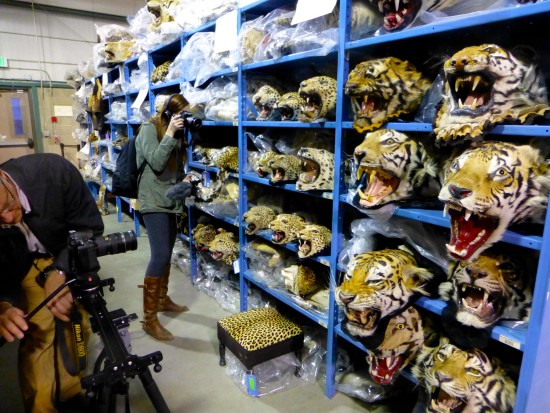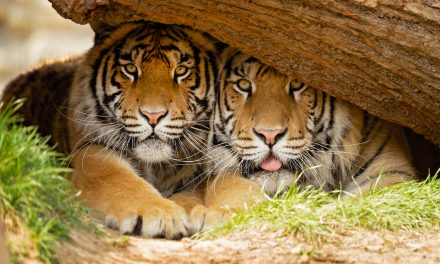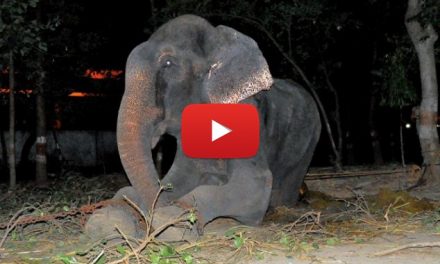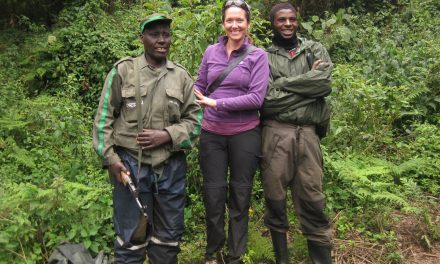
Inside the U.S. National Wildlife Property Repository. Photo: Wendy Worrall Redal
Within the open expanse of the Rocky Mountain Arsenal National Wildlife Refuge just outside Denver, you’ll find an unseemly sight – a large government building surrounded by short-grass prairie and wetlands. In contrast to the deer and bison roaming the plains and the raptors soaring overhead, the wildlife inside this building is not free – nor alive.
This 22,000-square-foot warehouse is the U.S. National Wildlife Property Repository. Inside are some 1.5 million items seized from the illegal wildlife trade.: snakeskin cowboy boots and leopard-fur coats, polished sea turtle shells and dried seahorses, bear paws, bear rugs and vials of bear bile, elephant-foot stools, mounted tigers and much more.

Elephant feet tables and foot stools on display inside the U.S. National Wildlife Property Repository. Photo: Wendy Worrall Redal
Yet the contents of the vast warehouse are just a fraction of the animal parts that enter the United States illegally every year as part of a growing $20 billion global industry that is threatening some species with extinction while enriching the cartels and crime syndicates that drive it.

Many Asian cultures wrongly ascribe medicinal or aphrodisiac powers to products made from illegal animal parts
Wildlife trafficking is the third most lucrative business in the world, behind illegal drug trade and human trafficking. And the Obama Administration is hoping an aggressive new plan to target traders and pressure Asian countries to crack down on illegal commerce in elephant ivory and rhinoceros horn will help slow the influx of seized animal parts that create a grisly display inside the repository.
The president’s National Strategy for Combating Wildlife Trafficking was recently announced following a two-year administration review on how to limit wildlife trafficking. Some of its provisions include using American intelligence agencies to track traffickers and sending U.S. agents abroad to combat trade at points of origin in Asia, Africa and South America.
The announcement was met with praise by anti-trafficking organizations, while also acknowledging that action will be difficult with only a small budget increase for enforcement efforts by the U.S. Fish and Wildlife Service. Inadequate staffing, which the new plan is unlikely to alter, means only an estimated 10 percent of wildlife traffickers are caught.
World Wildlife Fund’s Crawford Allan, quoted in The New York Times, said, “…[G]iven that there are still limited resources, the government needs to really focus its efforts and go after the criminal organizations behind the trade in the most critical areas both here and abroad.” Allan is senior director of Traffic, WWF’s wildlife trade monitoring network.

Wild cat parts seized by U.S. Fish and Wildlife Service law enforcement, U.S National Wildlife Property Repository. Photo: Wendy Worrall Redal
One of the most sobering experiences I have had was a personal visit to the warehouse during last year’s U.S. government-sponsored ivory crush, when six tons of illegal ivory were destroyed at the site. What struck me first was the sheer size of the place, with its rows and rows of stacked shelves – and then realizing that every one of them is full of wild animals and products created from them.

Confiscated items made from illegal wild animal parts. Many tourists and consumers do not realize their purchases support wildlife trafficking.
Most of the artifacts housed here by the U.S. Fish and Wildlife Service were seized by law enforcement officials at points of entry into the country. While many were confiscated from individuals intending to profit from selling them, plenty of others were bought by tourists abroad, not realizing that the products they had purchased were banned in the United States.
NPR’s Jackie Northam also toured the repository last month while reporting on the Obama Administration’s efforts to also stem illegal wildlife trade through international trade agreements with Asian and EU nations. The administration wants trade sanctions against any countries engaged in illegal wildlife trafficking to be part of the Trans-Pacific Partnership, a massive multilateral trade agreement currently being negotiated by a dozen nations in Asia and around the Pacific, including the U.S.
For a virtual tour of the repository, see this video story from The Atlantic. And to learn more about the facts, figures and impacts of illegal wildlife trafficking and how you can respond, visit WWF’s website.



































